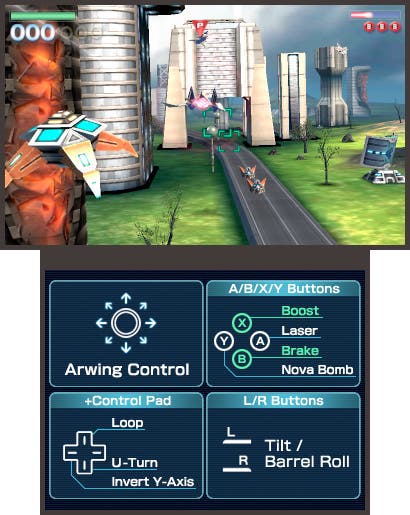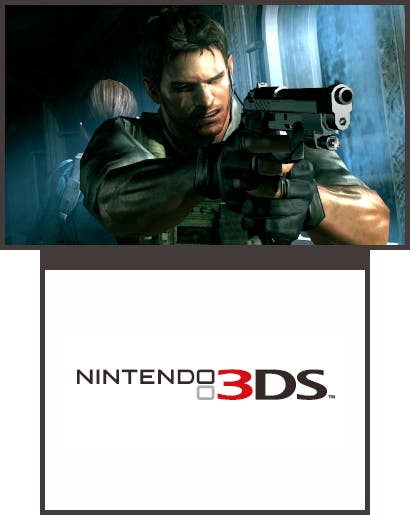Digital Foundry vs. 3DS
Tech talk and brand new demo analysis.
After skilfully negotiating our way through all three of the 3DS prototypes, we find that there are a total of three different playable samplers in among the non-interactive stuff.
Probably the simplest is called simply 3D Challenge. The idea is very straightforward, with each mini-game event showcasing a challenge based on the idea of 3D depth. The simplest puzzle sees you moving two strawberries about in 3D. One of them is flat, the other is a full 3D object. You're tasked with choosing which one is actually in 3D.
Ridiculously simple of course, but that is the base-level challenge. Moving up to a slightly more taxing one, three golf holes are displayed on-screen. However, two are flat pictures while only one is actually a hole with 3D depth. Select the right one and you're off to the next challenge.
An intermediate-level test sees you having to select one of three different routes - only one of which leads to the sparkling diamond prize. The thing here is that all three routes are fully realised in stereoscopic 3D, and operate in three different axis, intertwining and criss-crossing, so the task is somewhat more taxing than it initially sounds.
The other two playables consists of new renditions of two old Nintendo favourites. PilotWings Resort offers up two different levels for our consumption: a simple "fly through the rings" plane event and a "burst balloons in your jetpack" arrangement. The graphics are minimalistic and basic - certainly nothing like the same league as Resident Evil or Metal Gear - but the 3D works well, and the rebirth of the classic PilotWings series is bound to generate huge interest.
The final piece of playable action is a stereoscopic 3D rendition of Starfox 64. This is probably the most disappointing demo of the lot though. As it's derived directly from the N64 title textures are of a low quality, models are low-poly and the action just doesn't offer anything new or exciting.
It's interesting to note that Sony's conference earlier in the day championed the fact that its 2011 3D titles are designed from the ground up to support 3D, with the platform holder hinting heavily that adapted 2D titles just don't make the most of the 3D concept. Certainly in the case of Starfox 64 3D there is an element of pointlessness about the whole exercise.


However, returning to the non-interactive material, there is plenty to whet the appetite. Mario Kart 3DS takes the form a rolling demo showing the titular character bombing around the track dodging bananas, firing off koopa shells and generally indulging in the sort of karting action that has kept us enthralled since the series debuted on Super Nintendo.
However, since the game is only represented by a very simple demo, it's difficult to imagine how Nintendo will use the 3D concept to enhance gameplay. Racing titles can benefit immeasurably from 3D (as Sony often tells us when demoing MotorStorm, for example), but the realistic effects of that brand of stereo 3D are limited to the first-person perspective, while Mario Kart 3DS almost certainly retains the traditional third-person angle.
What we do see are fairly basic but nicely rendered 3D environments and some nicely detailed karts and characters. The game engine is clearly locked at 60FPS, and one particular section, where Mario propels his kart skywards, offers some impressive views of the track ahead.
If the reveal of a new handheld Mario Kart game isn't enough to get you excited, perhaps the return of Paper Mario will. Again, not a huge amount is shown, but the mixture of 3D environments and 2D paper characters is unique and enchanting within the auto-stereoscopic 3D setup of the new hardware.
Our demo session heads toward its conclusion with another look at the 3DS tech demo Nintendo showcased at the climax of its E3 conference. A range of Nintendo scenes and characters are rendered with consummate detail in full stereo 3D. Oli described this scene in depth in his hands-on briefing, but one thing that should be factored into the discussion is that this is clearly a technical demonstration designed to show 3D on the system looking at its best.
Oli pointed out that the Link section looked better than the new Wii game, Skyward Sword, but just rendering a single character with no environments, no user input and no game logic is obviously a lot easier on the hardware than incorporating that same model into a full-on game with detail-rich characters and environments.
That being the case, to compare 3DS with Wii, or even GameCube, in terms of graphical quality based on this beautiful demo probably doesn't do the home console justice. The best demos we see based on actual game assets are of Dreamcast quality. While this may seem like a disappointment, bear in mind that we're running on a very small screen here, with a fairly high pixel density that will magnify the impact of that level of horsepower. Generally speaking, 3DS is a hugely attractive platform.
